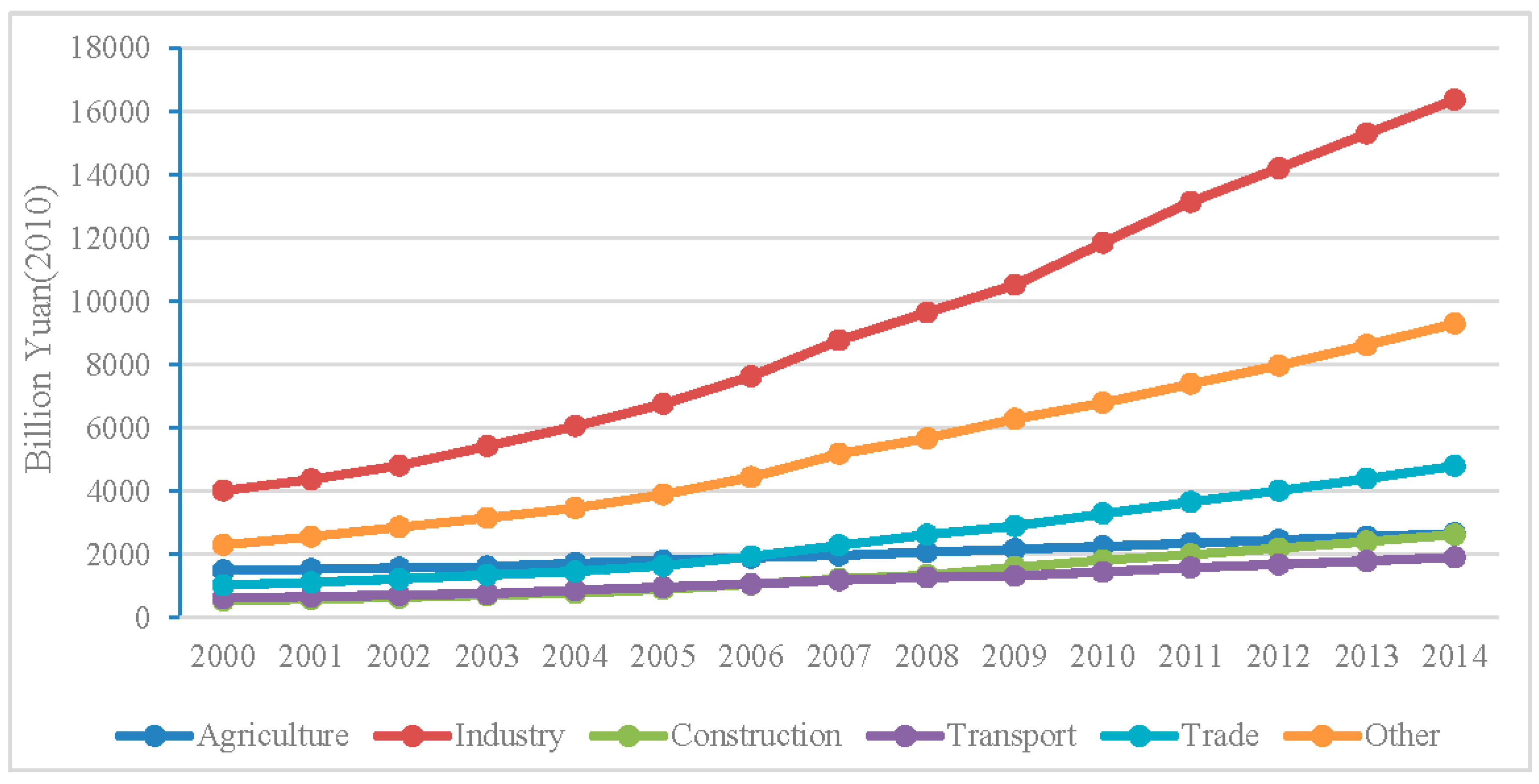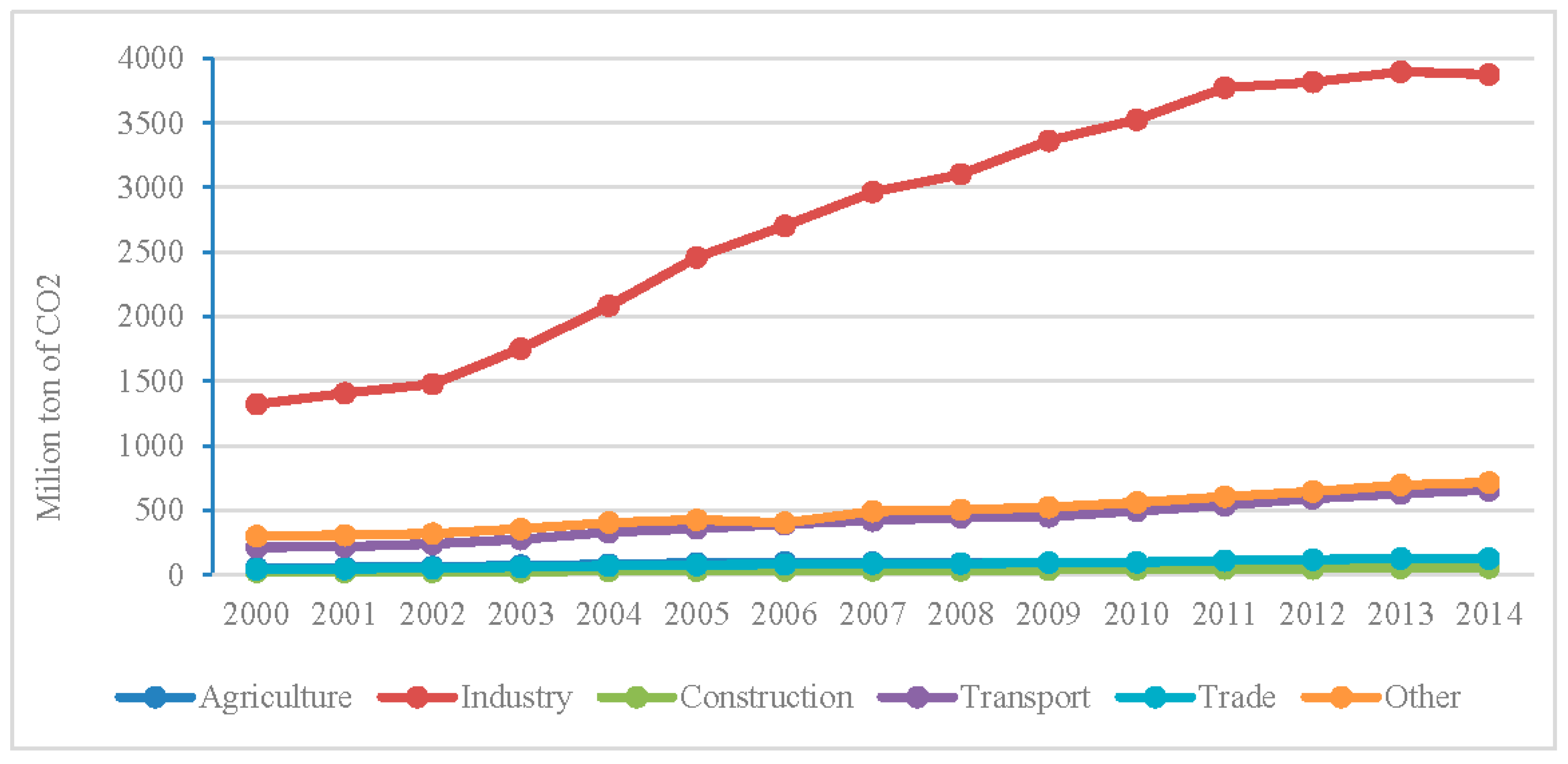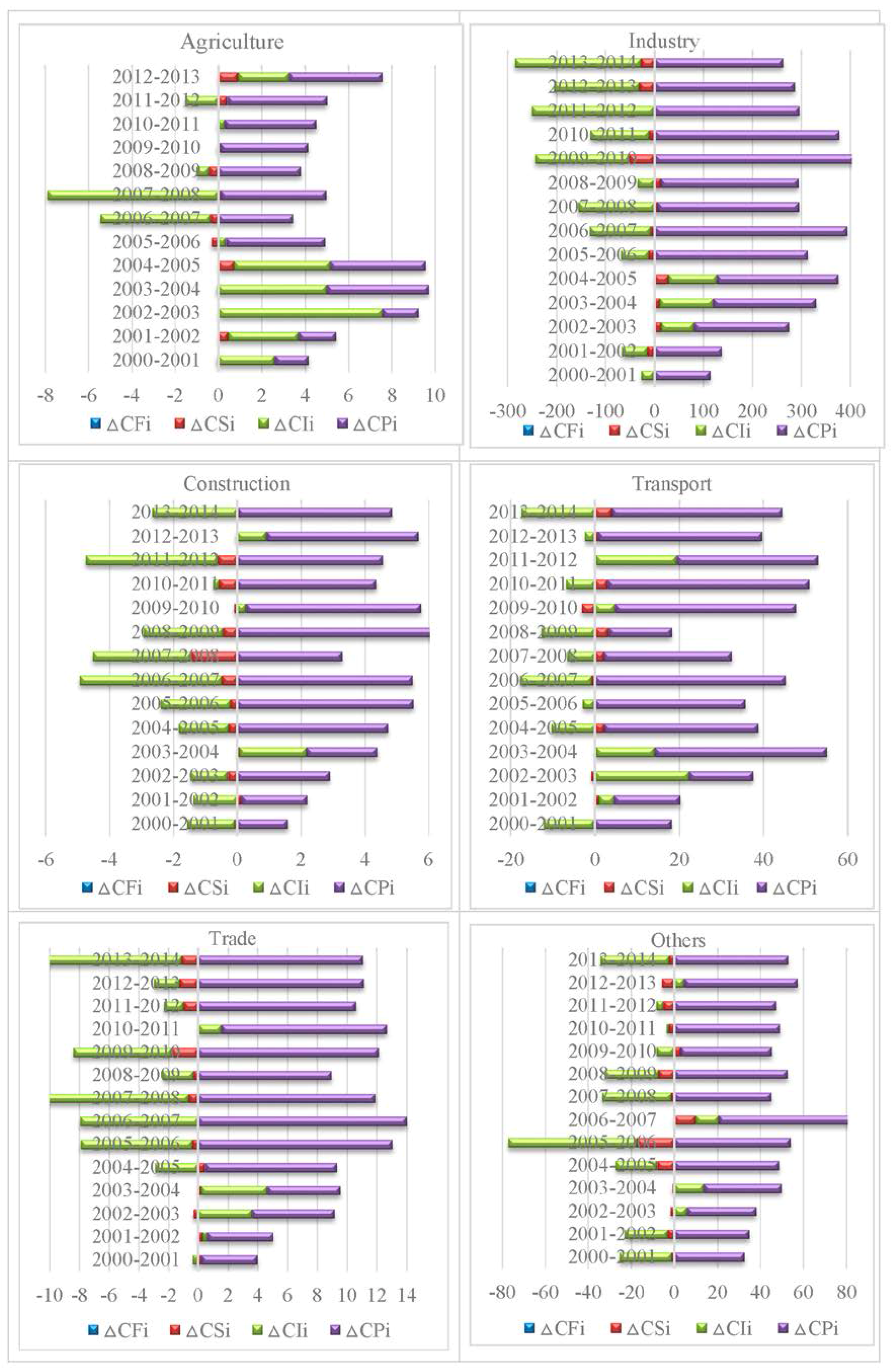Moving to a Low-Carbon Economy in China: Decoupling and Decomposition Analysis of Emission and Economy from a Sector Perspective
Abstract
:1. Introduction
2. Literature Review
3. Research Method and Data Collection
3.1. The Model of Calculating Sector’s CO2 Emission
3.2. Decoupling Model
3.3. Decomposition Technique
3.4. Data Collection
4. Results and Discussion
4.1. The Output Values and CO2 Emissions in Different Sectors
4.2. Analysis on the Decoupling Effect in Different Sectors
4.3. Decomposition Analysis of the Different Sectors
4.3.1. Cumulative Effect of Carbon Emission Factors in Different Sectors
4.3.2. Analysis of Effects upon Different Sectors
5. Conclusions and Policy Implications
5.1. Conclusions
- (1)
- The economic output and carbon emissions of the six sectors all grew from 2000 to 2014. The Industry sector was the main source of total CO2 emissions, accounting for the whole CO2 emissions of around 70%. The Other and Transport sectors had the second and third highest emission levels. The other three sectors (Agriculture, Trade and Construction) accounted for the total number of emissions of a lower proportion.
- (2)
- From 2000 to 2014, the decoupling status of CO2 emissions differed across different sectors in China. In terms of the ideal degree of low-carbon development, the six sectors were ranked as follows, from best to worst: Construction (weak decoupling), other (weak decoupling), Trade (weak decoupling), Industry (weak decoupling), Transport (expansive coupling) and Agriculture (expansive negative decoupling).
- (3)
- Different factors drive emissions across the six sectors differently, both in degree and direction. The economic effect is the primary driver of CO2 emissions across the six sectors and plays a positive role of improving CO2 emissions. According to contributions these factors provided, the next element was energy intensity effect, which advanced increasing CO2 emissions for Agriculture but play a negative role in the other sectors. The energy structure effect contributes to emissions of the Agriculture and Transport sectors and inhibited the effect on the CO2 emissions in other four sectors. Because single types of energy are used for each sector, the cumulative carbon coefficient effect was weak.
5.2. Policy Implications
- (1)
- Based on the total value of CO2 emissions and decoupling states in different sectors, the Industry sector turns out to be the main origin of total carbon emissions, the annual growth rate of CO2 emissions is largest for the Transport sector and the decoupling state of the Agriculture sector is expansive negative decoupling. These results indicate that the relevant departments should develop practical and feasible emission reduction targets and adopt differentiated industrial development policies.
- (2)
- For the Industry sector with the highest economic output and the most CO2 emissions, it is necessary to develop technological innovations in green low-carbon industries and realize industrial production modes that achieve greater economic output through low CO2 emissions.
- (3)
- The economic effect and energy intensity effect are determinants of CO2 emissions from different sectors, followed by the energy structure effect. Increases in industrial scale will result in an increase in carbon emissions. As such, reducing energy intensity and optimizing energy structure are critical measures for the sake of achieving low carbon development goals of different sectors. Energy efficiency should improve in the future by promoting low-carbon technologies and promoting and applying energy efficient equipment. In addition, improving the usage frequency and scope of clean energy (natural gas, hydropower, solar energy and wind energy) could effectively inhibit the economic growth effect on CO2 emissions.
Acknowledgments
Author Contributions
Conflicts of Interest
References
- Wang, Q.; Li, R. Decline in China’s coal consumption: An evidence of peak coal or a temporary blip? Energy Policy 2017, 108, 696–701. [Google Scholar] [CrossRef]
- Xinhua Ten Specific Measures to Help 70 Million People Out of Poverty. Available online: http://news.xinhuanet.com/politics/2015-12/10/c_128514139.htm. (accessed on 1 December 2015).
- Wang, W.; Li, M.; Zhang, M. Study on the changes of the decoupling indicator between energy-related CO2 emission and GDP in China. Energy 2017, 128, 11–18. [Google Scholar] [CrossRef]
- Wang, Q.; Chen, X. Energy policies for managing China’s carbon emission. Renew. Sustain. Energy Rev. 2015, 50, 470–479. [Google Scholar] [CrossRef]
- Mcmichael, A.J.; Powles, J.W.; Butler, C.D.; Uauy, R. Food, livestock production, energy, climate change, and health. Lancet 2007, 370, 1253. [Google Scholar] [CrossRef]
- Heggelund, G. China’s climate change policy: Domestic and international developments. Asian Perspect. 2007, 31, 155–191. [Google Scholar]
- Wang, Q.; Li, R. Journey to burning half of global coal: Trajectory and drivers of China’s coal use. Renew. Sustain. Energy Rev. 2016, 58, 341–346. [Google Scholar] [CrossRef]
- Wang, Q.; Chen, X. China’s electricity market-oriented reform: From an absolute to a relative monopoly. Energy Policy 2012, 51, 143–148. [Google Scholar] [CrossRef]
- Zhang, S.X.; Tang, X.W.; Management, S.O. The Decoupling Relationship between Carbon Emissions and Economic Growth of Construction Industry in Shaanxi Province. Ind. Eng. J. 2014, 17, 68–72. [Google Scholar] [CrossRef]
- Weizsäcker, E.U.V. Erdpolitik: Ökologische Realpolitik an der Schwelle zum Jahrhundert der Umwelt; Wissenschaftliche Buchgesellschaft: Darmstadt, Germany, 1990. [Google Scholar]
- The Organisation for Economic Co-operation and Development. Sustainable Development: Indicators to Measure Decoupling of Environmental Pressure From Economic Growth; OECD: Paris, France, 2002. [Google Scholar]
- Tapio, P. Towards a theory of decoupling: Degrees of decoupling in the EU and the case of road traffic in Finland between 1970 and 2001. Transp. Policy 2005, 12, 137–151. [Google Scholar] [CrossRef]
- Climent, F.; Pardo, A. Decoupling factors on the energy–output linkage: The Spanish case. Energy Policy 2007, 35, 522–528. [Google Scholar] [CrossRef]
- Wang, Q.; Li, R.; Jiang, R. Decoupling and Decomposition Analysis of Carbon Emissions from Industry: A Case Study from China. Sustainability 2016, 8, 1059. [Google Scholar] [CrossRef]
- Wang, Q.; Jiang, X.-T.; Li, R. Comparative decoupling analysis of energy-related carbon emission from electric output of electricity sector in Shandong Province, China. Energy 2017, 127, 78–88. [Google Scholar] [CrossRef]
- Zhong, T.Y.; Huang, X.J.; Han, L.; Wang, B.Y. Review on the Research of Decoupling Analysis in the Field of Environments and Resource. J. Nat. Resour. 2010, 25, 1400–1412. [Google Scholar]
- Jiang, R.; Li, R. Decomposition and Decoupling Analysis of Life-Cycle Carbon Emission in China’s Building Sector. Sustainability 2017, 9, 793. [Google Scholar] [CrossRef]
- Li, R.; Jiang, R. Moving Low-Carbon Construction Industry in Jiangsu Province: Evidence from Decomposition and Decoupling Models. Sustainability 2017, 9, 1013. [Google Scholar] [CrossRef]
- Li, Z.; Han, C.; Yao, Y. A Study on the Influent Factors of Decoupling of Industrial Low-carbonization. Econ. Manag. 2010, 24, 41–44. [Google Scholar]
- Zhang, M.; Wang, W. Decouple indicators on the CO2 emission-economic growth linkage: The Jiangsu Province case. Ecol. Indic. 2013, 32, 239–244. [Google Scholar] [CrossRef]
- Zhongwu, L.U.; Wang, H.; Qiang, Y. Decoupling Indicators: Quantitative Relationships between Resource Use, Waste Emission and Economic Growth. Resour. Sci. 2011, 33, 2–9. [Google Scholar]
- Wang, Q.; Li, R. Research status of shale gas: A review. Renew. Sustain. Energy Rev. 2017, 74, 715–720. [Google Scholar] [CrossRef]
- Wang, Q.; Li, R. Natural gas from shale formation: A research profile. Renew. Sustain. Energy Rev. 2016, 57, 1–6. [Google Scholar] [CrossRef]
- Wang, Q.; Li, R. Impact of cheaper oil on economic system and climate change: A SWOT analysis. Renew. Sustain. Energy Rev. 2016, 54, 925–931. [Google Scholar] [CrossRef]
- Freitas, L.C.D.; Kaneko, S. Decomposing the decoupling of CO2 emissions and economic growth in Brazil. Ecol. Econ. 2011, 70, 1459–1469. [Google Scholar] [CrossRef]
- Zhang, M.; Bai, C.; Zhou, M. Decomposition analysis for assessing the progress in decoupling relationship between coal consumption and economic growth in China. Resour. Conserv. Recycl. 2016, 129, 454–462. [Google Scholar] [CrossRef]
- Zhou, X.; Zhang, M.; Zhou, M.; Zhou, M. A comparative study on decoupling relationship and influence factors between China’s regional economic development and industrial energy-related carbon emissions. J. Clean. Prod. 2016, 142, 783–800. [Google Scholar] [CrossRef]
- Andreoni, V.; Galmarini, S. Decoupling economic growth from carbon dioxide emissions: A decomposition analysis of Italian energy consumption. Energy 2012, 44, 682–691. [Google Scholar] [CrossRef]
- Caneghem, J.V.; Block, C.; Hooste, H.V.; Vandecasteele, C. Eco-efficiency trends of the Flemish industry: Decoupling of environmental impact from economic growth. J. Clean. Prod. 2010, 18, 1349–1357. [Google Scholar] [CrossRef]
- Zhao, X.; Zhang, X.; Li, N.; Shao, S.; Geng, Y. Decoupling economic growth from carbon dioxide emissions in China: A sectoral factor decomposition analysis. J. Clean. Prod. 2016, 142, 3500–3516. [Google Scholar] [CrossRef]
- Luo, Y.; Long, X.; Wu, C.; Zhang, J. Decoupling CO2 emissions from economic growth in agricultural sector across 30 Chinese provinces from 1997 to 2014. J. Clean. Prod. 2017, 159, 220–228. [Google Scholar] [CrossRef]
- Zhao, X.; Zhang, X.; Shao, S. Decoupling CO2 Emissions and Industrial Growth in China over 1993–2013: The Role of Investment. Energy Econ. 2016, 60, 275–292. [Google Scholar] [CrossRef]
- Wang, Y.; Xie, T.; Yang, S. Carbon emission and its decoupling research of transportation in Jiangsu Province. J. Clean. Prod. 2017, 142, 907–914. [Google Scholar] [CrossRef]
- Sheinbaum, C.; Ozawa, L.; Castillo, D. Using logarithmic mean Divisia index to analyze changes in energy use and carbon dioxide emissions in Mexico’s iron and steel industry. Energy Econ. 2010, 32, 1337–1344. [Google Scholar] [CrossRef]
- Wang, Q.; Li, R. Drivers for energy consumption: A comparative analysis of China and India. Renew. Sustain. Energy Rev. 2016, 62, 954–962. [Google Scholar] [CrossRef]
- Lu, Q.; Yang, H.; Huang, X.; Chuai, X.; Wu, C. Multi-sectoral decomposition in decoupling industrial growth from carbon emissions in the developed Jiangsu Province, China. Energy 2015, 82, 414–425. [Google Scholar] [CrossRef]
- Lin, B.; Moubarak, M. Decomposition analysis: Change of carbon dioxide emissions in the Chinese textile industry. Renew. Sustain. Energy Rev. 2013, 26, 389–396. [Google Scholar] [CrossRef]
- Wang, Q.; Hang, Y.; Zhou, P.; Wang, Y. Decoupling and attribution analysis of industrial carbon emissions in Taiwan. Energy 2016, 113, 728–738. [Google Scholar] [CrossRef]
- Ren, S.; Yin, H.; Chen, X.H. Using LMDI to analyze the decoupling of carbon dioxide emissions by China’s manufacturing industry. Environ. Dev. 2014, 9, 61–75. [Google Scholar] [CrossRef]
- Liu, L.C.; Fan, Y.; Wu, G.; Wei, Y.M. Using LMDI method to analyze the change of China’s industrial CO2 emissions from final fuel use: An empirical analysis. Energy Policy 2007, 35, 5892–5900. [Google Scholar] [CrossRef]
- Zhao, M.; Tan, L.; Zhang, W.; Ji, M.; Liu, Y.; Yu, L. Decomposing the influencing factors of industrial carbon emissions in Shanghai using the LMDI method. Energy 2010, 35, 2505–2510. [Google Scholar] [CrossRef]
- Ang, B.W. LMDI decomposition approach: A guide for implementation. Energy Policy 2015, 86, 233–238. [Google Scholar] [CrossRef]
- Costanza, R. Economic growth, carrying capacity, and the environment. Science 1995, 268, 520. [Google Scholar] [CrossRef]
- Ang, B.W. Decomposition analysis for policymaking in energy: Which is the preferred method? Energy Policy 2004, 32, 1131–1139. [Google Scholar] [CrossRef]
- Diakoulaki, D.; Mandaraka, M. Decomposition analysis for assessing the progress in decoupling industrial growth from CO2 emissions in the EU manufacturing sector. Energy Econ. 2007, 29, 636–664. [Google Scholar] [CrossRef]
- Rikkonen, P.; Tapio, P. Future prospects of alternative agro-based bioenergy use in Finland—Constructing scenarios with quantitative and qualitative Delphi data. Technol. Forecast. Soc. Chang. 2009, 76, 978–990. [Google Scholar] [CrossRef]
- Tapio, P.; Banister, D.; Luukkanen, J.; Vehmas, J.; Willamo, R. Energy and transport in comparison: Immaterialisation, dematerialisation and decarbonisation in the EU15 between 1970 and 2000. Energy Policy 2007, 35, 433–451. [Google Scholar] [CrossRef]
- Xu, S.C.; He, Z.X.; Long, R.Y. Factors that influence carbon emissions due to energy consumption in China: Decomposition analysis using LMDI. Appl. Energy 2014, 127, 182–193. [Google Scholar] [CrossRef]
- Raupach, M.R.; Marland, G.; Ciais, P.; Le, Q.C.; Canadell, J.G.; Klepper, G.; Field, C.B. Global and regional drivers of accelerating CO2 emissions. Proc. Natl. Acad. Sci. USA 2007, 104, 10288–10293. [Google Scholar] [CrossRef] [PubMed]




| Degree of Decoupling | |||
|---|---|---|---|
| Strong decoupling | <0 | >0 | <0 |
| Weak decoupling | >0 | >0 | 0.8 > > 0 |
| Expansive coupling | >0 | >0 | 1.2 > > 0.8 |
| Expansive negative decoupling | >0 | >0 | >1.2 |
| Strong negative decoupling | >0 | <0 | <0 |
| Weak negative decoupling | <0 | <0 | 0.8 > > 0 |
| Recessive coupling | <0 | <0 | 1.2 > > 0.8 |
| Recessive decoupling | <0 | <0 | >1.2 |
| Fuel Source | Carbon Coefficient | |
|---|---|---|
| 1 | raw coal | 1.981 |
| 2 | cleaned coal | 2.405 |
| 3 | other washed coal | 0.955 |
| 4 | coke | 2.86 |
| 5 | crude oil | 3.02 |
| 6 | gasoline | 2.925 |
| 7 | kerosene | 3.033 |
| 8 | diesel oil | 3.096 |
| 9 | fuel oil | 3.17 |
| 10 | LPG | 3.101 |
| 11 | refinery gas | 3.012 |
| 12 | natural gas | 21.622 |
| 13 | electricity | 1.239 |
| ΔC/C | ΔGDP/GDP | e | Decoupling State | |
|---|---|---|---|---|
| Agriculture | 1.189 | 0.786 | 1.512 | Expansive negative decoupling |
| Industry | 1.932 | 3.068 | 0.630 | Weak decoupling |
| Construction | 1.358 | 3.756 | 0.361 | Weak decoupling |
| Transport | 2.082 | 2.108 | 0.988 | Expansive coupling |
| Trade | 1.927 | 3.661 | 0.526 | Weak decoupling |
| Other | 1.377 | 3.030 | 0.455 | Weak decoupling |
© 2018 by the authors. Licensee MDPI, Basel, Switzerland. This article is an open access article distributed under the terms and conditions of the Creative Commons Attribution (CC BY) license (http://creativecommons.org/licenses/by/4.0/).
Share and Cite
Jiang, R.; Zhou, Y.; Li, R. Moving to a Low-Carbon Economy in China: Decoupling and Decomposition Analysis of Emission and Economy from a Sector Perspective. Sustainability 2018, 10, 978. https://doi.org/10.3390/su10040978
Jiang R, Zhou Y, Li R. Moving to a Low-Carbon Economy in China: Decoupling and Decomposition Analysis of Emission and Economy from a Sector Perspective. Sustainability. 2018; 10(4):978. https://doi.org/10.3390/su10040978
Chicago/Turabian StyleJiang, Rui, Yulin Zhou, and Rongrong Li. 2018. "Moving to a Low-Carbon Economy in China: Decoupling and Decomposition Analysis of Emission and Economy from a Sector Perspective" Sustainability 10, no. 4: 978. https://doi.org/10.3390/su10040978




